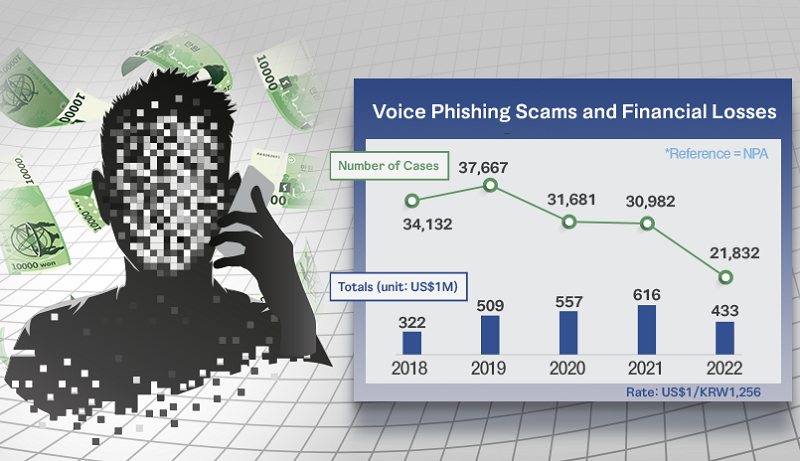[Feb] Voice phishing analysis system identifying Korean-speaking scammers
Date Feb 20, 2023
 Voice phishing has become a major crime in Korea, with the number of cases hovering over 30,000 every year and the total amount scammed increasing. (Courtesy of Integrated Data Analysis Center)
Voice phishing has become a major crime in Korea, with the number of cases hovering over 30,000 every year and the total amount scammed increasing. (Courtesy of Integrated Data Analysis Center)
Since the first case was reported here in 2006, voice phishing has become one of the most serious crimes in Korea, with tens of thousands of residents scammed every year.
People are well aware of such crimes and are constantly being informed about how to avoid becoming victims. Still, the number of voice phishing cases remains high, and the amount of money stolen continues to rise as the scams and technology used have also become more sophisticated.
According to police data, there were more than 30,000 cases of voice phishing annually in recent years, and the size of losses grew from 247 billion won (US$196.6 million) in 2017 to 404 billion won in 2018, 639.8 billion won in 2019, 700 billion won in 2020 and 774.4 billion won in 2021. The increasing trend was curbed last year only after a pan-government investigation team was launched in July – consisting of the Korean National Police Agency, Prosecution Service, Financial Supervisory Service, National Tax Service, Korea Customs Service and the Korea Communications Commission – with the number of cases dropping to 21,832 and the amount to 543.8 billion won.
The government also came up with another tool to crack down on voice phishing crimes: a voice data analysis system capable of identifying Korean-speaking scammers.
Led by the Integrated Data Analysis Center (IDAC) under the Ministry of the Interior and Safety, the system was developed because of limitations found in the foreign-designed programs being used by Korea’s law enforcement authorities and the National Forensic Service (NFS).

The foreign language-based systems initially used were not quite suitable for analyzing and identifying Korean-speaking voices. They failed to correctly link the same voice recorded in different phishing cases in as many as 62 percent of the relevant cases. What’s more, while voice phishing scammers usually operate in groups, the foreign voice analysis systems could not accurately ascertain if the people involved in one phishing case were part of the same group that took part in another.
These limitations made it difficult for the police to accurately pinpoint the voices of criminals even though a vast amount of speech data had been amassed through recorded phishing calls.
Jointly with the NFS and Seoul National University’s Institute of New Media and Communications, the IDAC created Korea’s own analysis system by using deep-learning technologies and having an artificial intelligence (AI) program repeatedly study some 1 million pieces of voice data, including about 100,000 from more than 500 Korean-speaking scammers.
With the new system, if a voice phishing criminal is caught, the police can run his or her voice through the database and look for a match to check if the person was involved in other cases.
While the accuracy rate for finding matches among speakers of Korean averaged 28.7 percent when using foreign systems, the indigenously developed program has a 51 percent accuracy rate, according to the center.
In addition, the new system can detect accomplices in a voice phishing ring.
“For example, in one phishing crime, there could be a scammer who pretends to be a prosecutor and another who acts like a detective. But in a different case, they may switch roles, or a third person might appear, who has ties to an entirely different case. The new system can detect that they are all in the same group,” said Kim Chul, director of the center.
“With this system, if only one member of the ring is caught, the police can get information about the other members more easily. It is the world’s first voice analysis system that can be used directly in a police investigation,” Kim added.
He said the new system was developed to specifically analyze Korean-language phishing cases, but the developers studied around 900,000 pieces of voice data in other languages as well. As a result, it is capable of analyzing almost all languages.
“This new system is expected to help speed up the police’s investigation into voice phishing crimes and detect more scammers,” Kim said.

The Ministry of Culture, Sports and Tourism's "Korea Here & Now" work can be used under the condition of "Public Nuri Type 1 (Source Indication)."




